Things to do in Trieste range from sipping coffees in the former mahogany-paneled haunts of James Joyce to shielding your eyes on the Audace Pier as you watch yacht races in the Adriatic Sea.
Trieste was once a major port for the Austro-Hungarian Empire and its haughty avenues and grand buildings are purpose-built for plume-helmeted horse parades. On Italy’s northeastern edge, It’s also a cultural melting pot where the unique mix of regional influences gives the city its cosmopolitan vibe.
Then there’s the waterfront, with its parasol pines and regimented gardens. Strolling this breezy promenade is one of the best things to do in Trieste, Italy. Let the sea breezes ruffle your hair, pause for a pillowy cappuccino, and set out to explore this enchanting city.
Explore Miramare Castle
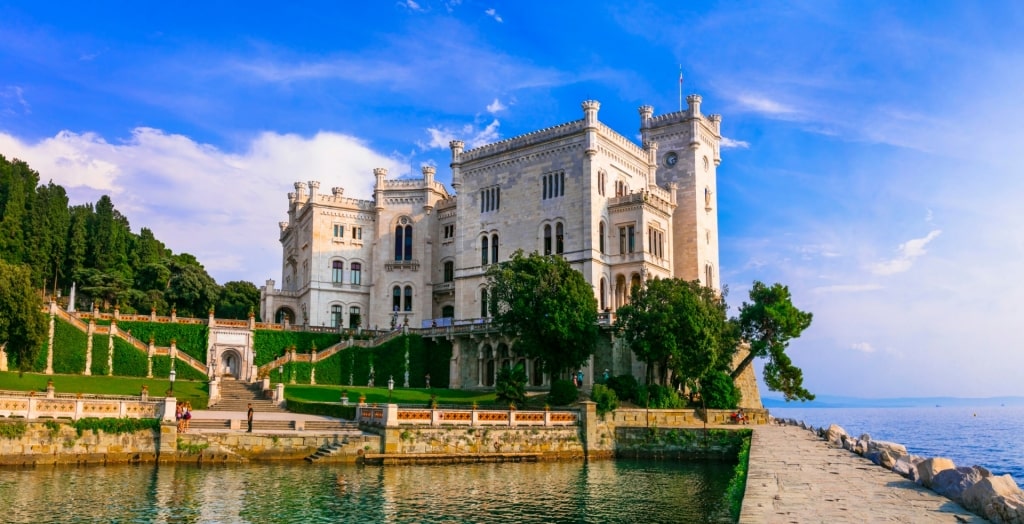
Miramare Castle
A symbol of this grand Italian port city, Miramare Castle is an elegant 19th-century fortification fit for an archduke.
Once the address of Ferdinand Maximilian, archduke of the Austrian-Hungarian Empire, this impressive pile is prominently placed on the verdant Grignano Promontory. Ferdinand, so the story goes, was driven to shelter there after sailing into a squall.
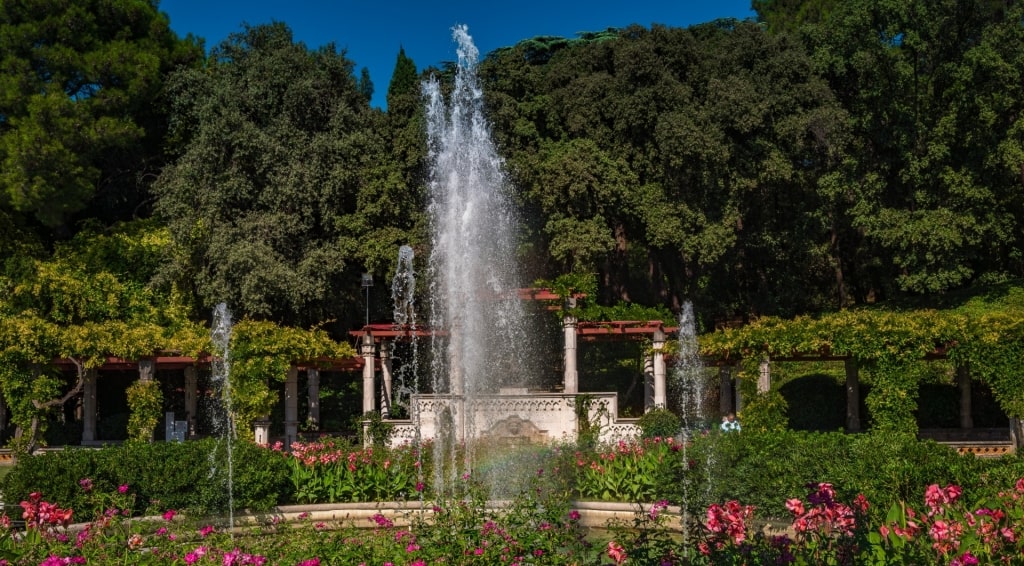
Garden of Miramare Castle
Today it’s a historic house museum for those who want to wander amid Habsburgian excess. It’s also the location of one of Italy’s most beautiful gardens.
A keen botanist, Maximilian hand-plucked species from the northern hemisphere and the Mediterranean for replanting in his sunny 54 acres. With the gravel crunching beneath your shoes, wander amid splashing fountains and the fragrance of Spanish spruce while searching out the ruined chapel folly.
Marvel at the Church of San Nicolò

Church of San Nicolò
Like most of the major buildings in Trieste, the Greek Orthodox Church of San Nicolò is found close to the seafront, in the Borgo Teresiano district.
Built towards the end of the 18th century, this place of worship had dual symbolism for the citizens of this port city. It acts as both a symbol of the city’s Byzantine heritage and, with its dedication to the patron saint of sailors, stands as a testament to Trieste’s impressive maritime history.
Approaching its relatively austere facade, you’re barely prepared for the riot of gilt and marble within. Frescos, mosaics, and heavily framed paintings ornament the interior depicting bible scenes and portraits of saints.

Borgo Teresiano
Once you’ve soaked up the ebullient serenity of the Church of San Nicolò, take time to explore Borgo Teresiano. Named for Empress Maria Theresa of Austria, the quarter lives up to the grandeur of its namesake with stout merchant palaces arranged on a grid layout.
The picturesque Canal Grande runs through here, and you’ll also find some of Trieste’s best shopping. Beyond the boutiques, you’ll see plenty of bookstores, including the rarities-stuffed Saba bookshop, once the haunt of intellectuals such as Italo Svevo.
Stroll Around Piazza Borsa
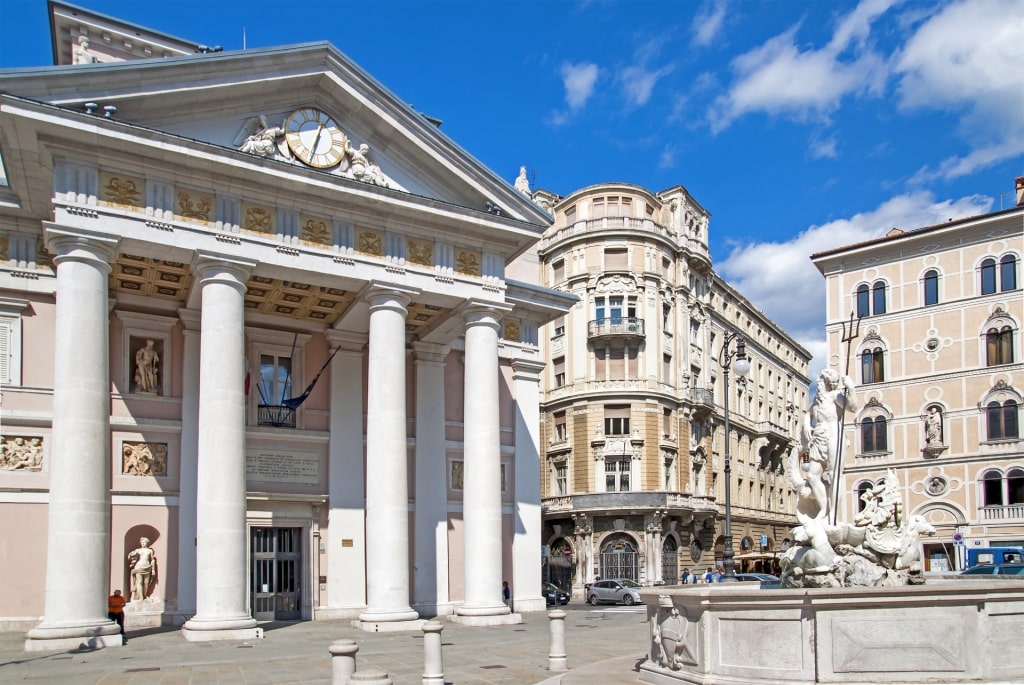
Piazza Borsa
The heart of commerce in the city in the 19th century, Piazza Borsa is one of the best places to explore in Trieste.
As it’s located in the center of the city, visitors tend to naturally find their way to this grand square. It’s adorned with ornate facades, porticoes, and cafés tended by busy, white-aproned waiters.
The grand Neptune Fountain poses in its center, with the sea god looking casual as if he’s waiting at the bar for his espresso.
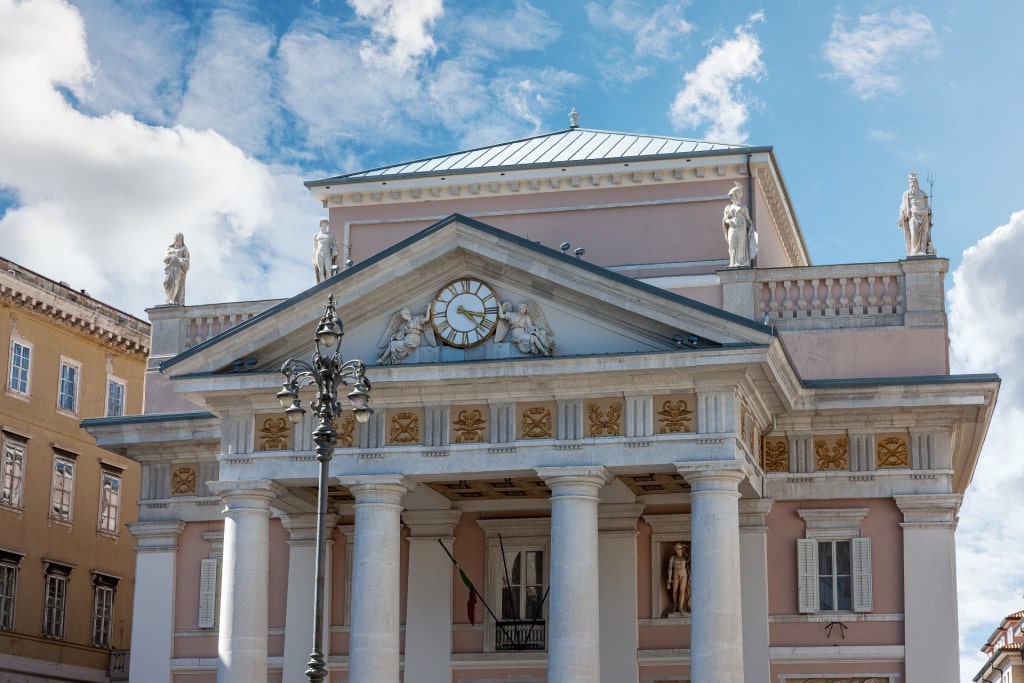
Palazzo della Borsa Vecchia
Of all of its impressive buildings, the neoclassical, peach-hued pomp of the Palazzo della Borsa Vecchia commands the most attention. Formerly the home of the city’s stock exchange, this Wall Street of Trieste is still employed for matters of civic commerce.
In front of the palace, there stands a statue of Leopold I of Austria that dates back to 1660. Leopold was the father of Charles VI, the Holy Roman Emperor who designated Trieste as a free port in 1719, leading to a surge in economic activity. Raise a glass to him at the historic Antico Caffe Torinese nearby.
Pay Your Respects at Teatro Verdi
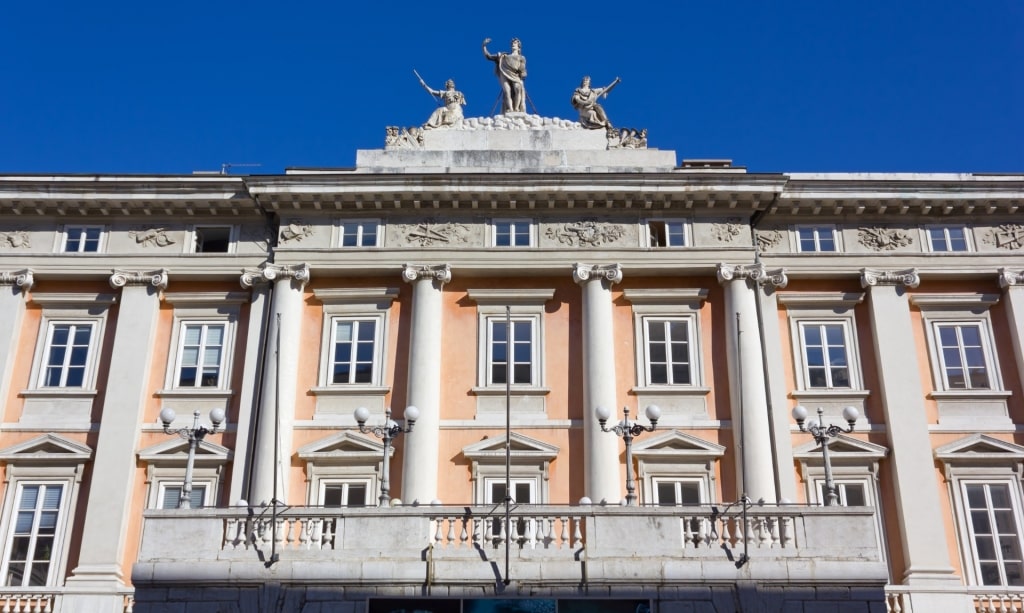
Teatro Verdi
Perhaps the most eye-catching of the architectural welcoming committee lining the waterfront, the Teatro Verdi is the city’s main theater and opera house.
It’s easily recognized by its immense width, impressive neoclassical portico, and crowning statuary representing the muses. Originally named Teatro Nuovo when it was built in 1801, the building’s design inspiration was drawn from the famous Scala Theater in Milan.
It was rechristened a century later in honor of the passing of the composer Giuseppe Verdi.
Its interior is as impressive as you’d expect, operatically garbed in crimson and gold. Concerts, both classical and pop, are held here, as well as theater productions and operas.
Of course, catching a Verdi opera at Teatro Verdi would be one of the bucket list things to do in Trieste, Italy.
Take in the Views From San Giusto Castle
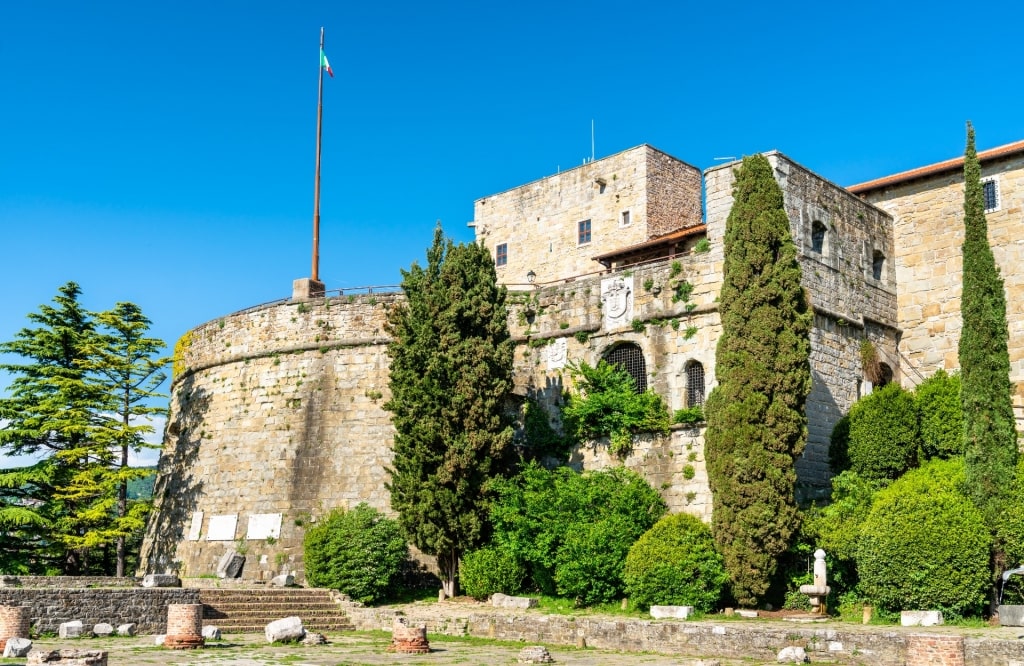
San Giusto Castle
Perched on a small hill in the city, the 14th-century San Giusto Castle has long provided the city with a sense of security.
In such a strategically useful situation, it’s little surprise that prehistoric and Roman ruins are also found on San Giusto Hill. The fortress was built in 1468 before being strengthened by the Venetians to become the distinct, triangular structure that stands today.
Visitors can explore the castle’s maze-like corridors and visit its artifact-stuffed Museo del Castello. However, many spend the majority of their time on the wide ramparts, taking in the outstanding panoramas over the city and the sailboat-spotted Gulf of Trieste.
If you’d prefer not to walk up the hill to the castle, you can find an elevator in the underground car park to the right of the Roman Theatre.
Wander Around Piazza Unità d’Italia

Piazza Unità d’Italia
Trieste’s main square, Piazza Unità d’Italia, is a perfect representation of the city. Rippling sunlight flows off the Adriatic to flood the regal facades forming three sides of the piazza. It’s considered Europe’s largest square that’s open to the sea.
With its Habsburg-era pomp and immense proportions, its 19th-century name of Piazza Grande seems highly suitable. However, when Trieste was incorporated into the newly unified Italian state, it was renamed Piazza Unità.

Town Hall
Fully restored at the turn of the millennium, its 18th and 19th-century buildings, including the Town Hall and the Palazzo del Governo, look extremely well kept for having faced oncoming sea winds for over a century.
Pause while walking the square’s historic flagstones to decode the baroque Fontana dei Quattro Continenti (Four Continents Fountain). The fountain, dating back to 1750, has statues that represent Europe, Africa, America, and Asia (then the four known areas of the world).
Visit the Roman Theater
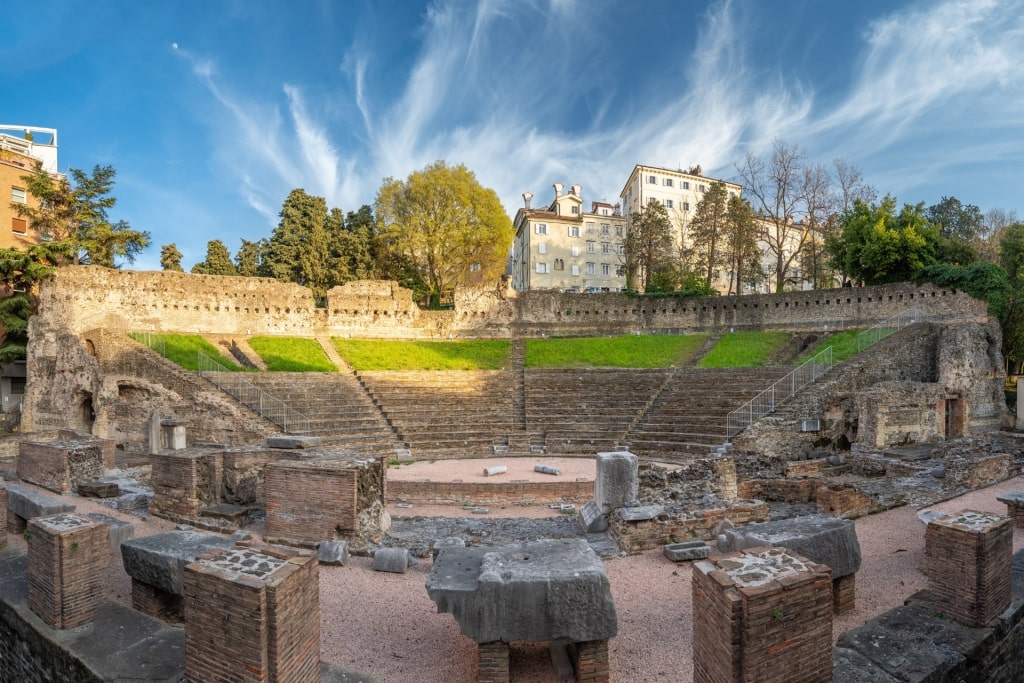
Roman Theater
Trieste, despite its multi-cultural weave, is based on the edge of the Italian peninsula. Therefore, Roman ruins are plentiful.
As with the rest of Trieste’s architecture, the Roman remains are impressive. There’s the Arco di Riccardo, the entrance to Trieste in Roman times, as well as a Roman Forum that was once the administrative heart of Tergeste, Trieste’s Roman name.
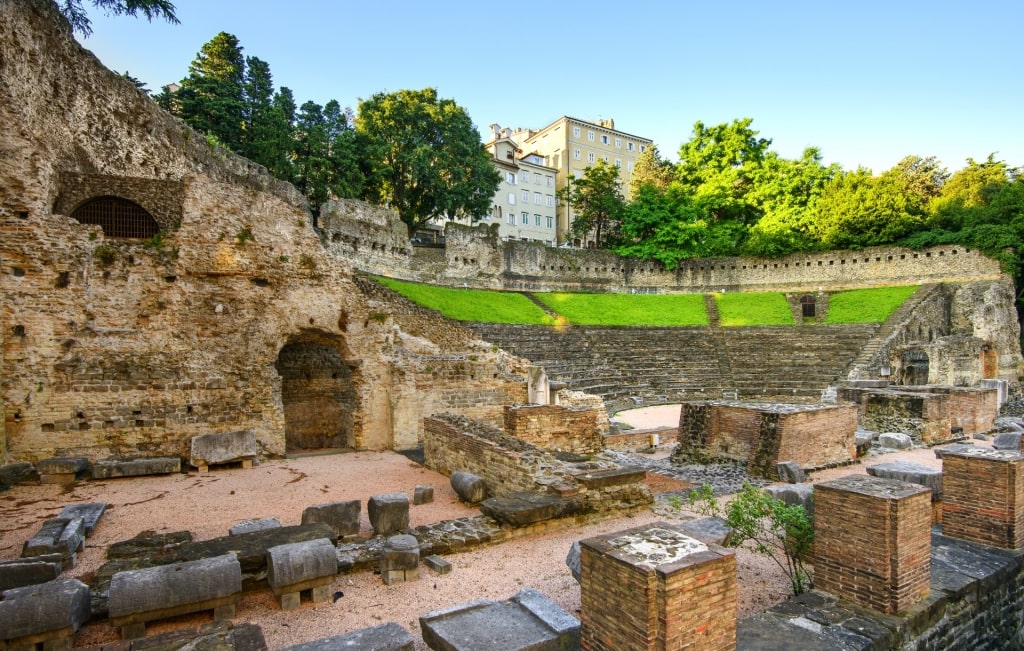
Roman Theater
Perhaps the most impressive, tucked away behind Piazza Unità d’Italia, is the Roman Theater. Once capable of holding close to 3,500 spectators, who would have enjoyed the Adriatic as a backdrop to their entertainment, the theater today is a grassy, tiered depression enclosed by houses.
The Theater was only rediscovered in 1938 during a period of urban regeneration. As it was carefully unearthed, the archaeologists found statue fragments among a haul of ancient treasures that you can explore in the city’s Orto Lapidaria museum.
Hike to Vittoria Lighthouse
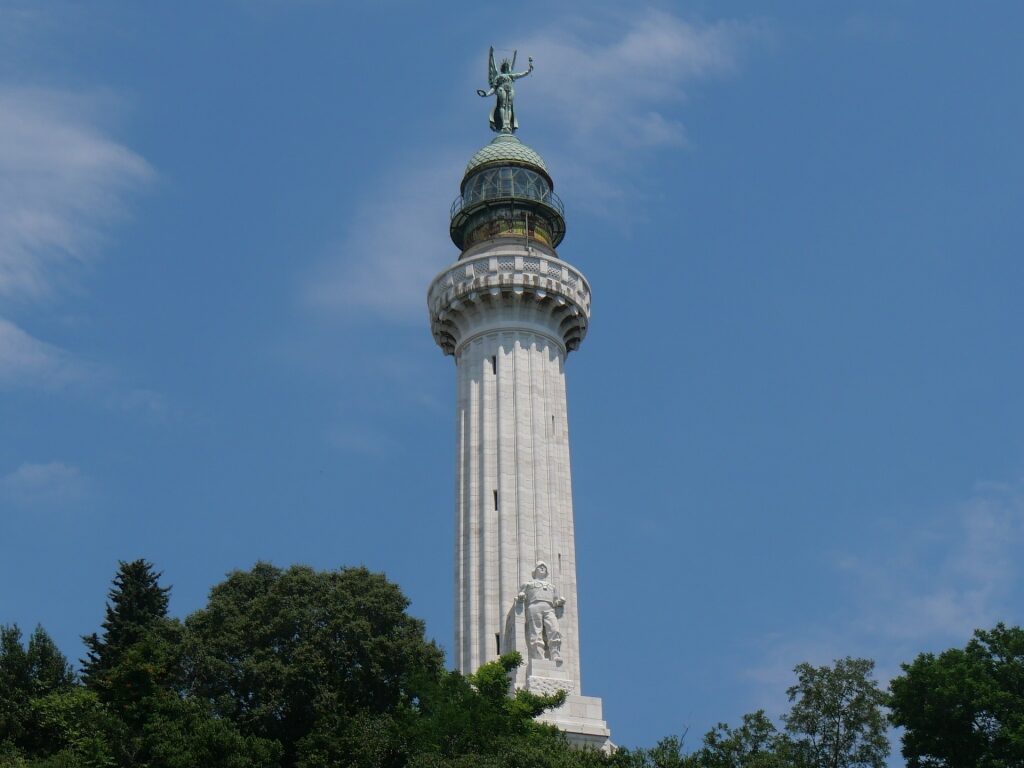
Vittoria Lighthouse
An icon of the city, the Vittoria Lighthouse is a 220-foot assertion of Trieste’s impressive maritime heritage.
It’s easy to spot. Set on Gretto Hill and built on the foundations of a former Austrian fort, the lighthouse was conceived as a post-World War I monument. Its towering height was intended to surpass the Berlin Victory Column. Topping its handsome design is a copper statue representing Victory.
A hike up here, on the northern edges of Trieste, rewards you with wonderful views over the coast. The very best views are found at the lighthouse’s top, once you’ve conquered the nearly 300 steps within its stone-sided column.
Tour the Sobering Risiera di San Sabba
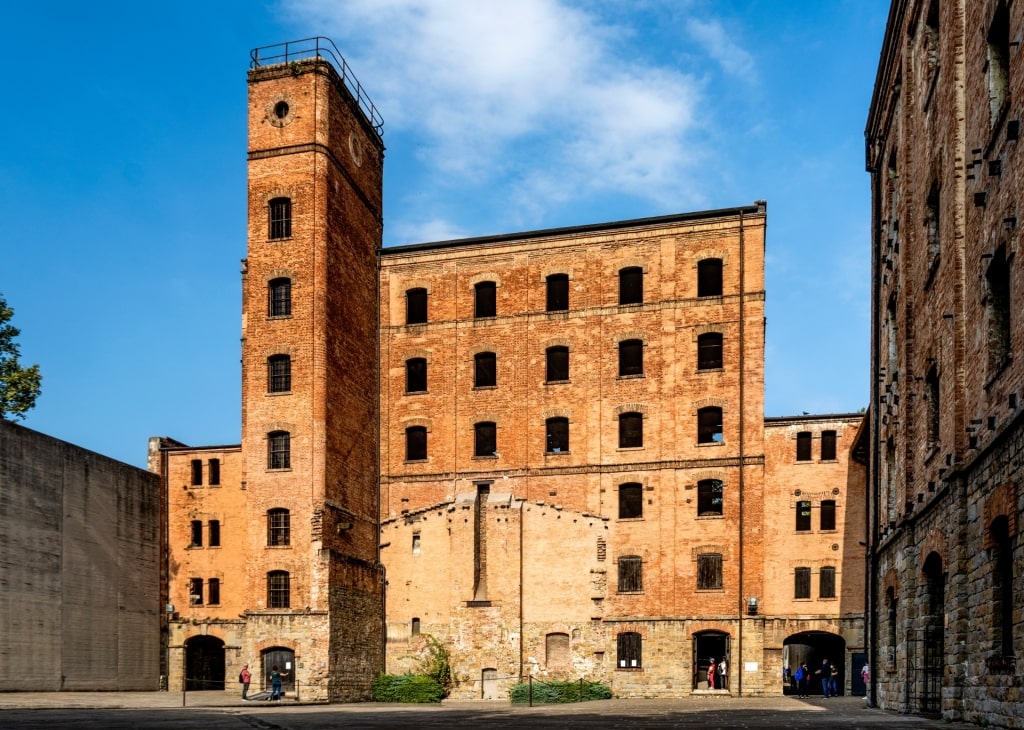
Risiera di San Sabba
A visit to Risiera di San Sabba is one of the most affecting things to do in Trieste. This five-story brick rice mill was repurposed by the Nazis as a concentration camp in World War II. Today, Risiera di San Sabba has since been transformed again into a museum and memorial to the horrors that took place here.
It was used by the Nazis as both a transit station and an extermination site for thousands of Jews, political prisoners, and members of the resistance. Risiera di San Sabba has added notoriety as having been the only camp in Italy with an on-site crematorium.
Touring the museum, you’ll see the ovens used to dispose of bodies, prisoner-holding cells, and collections of letters sent by those being detained within Risiera di San Sabba. You’ll find this solemn national monument in the Servola suburb, south of the city center.
Gaze at Cattedrale di San Giusto Martire
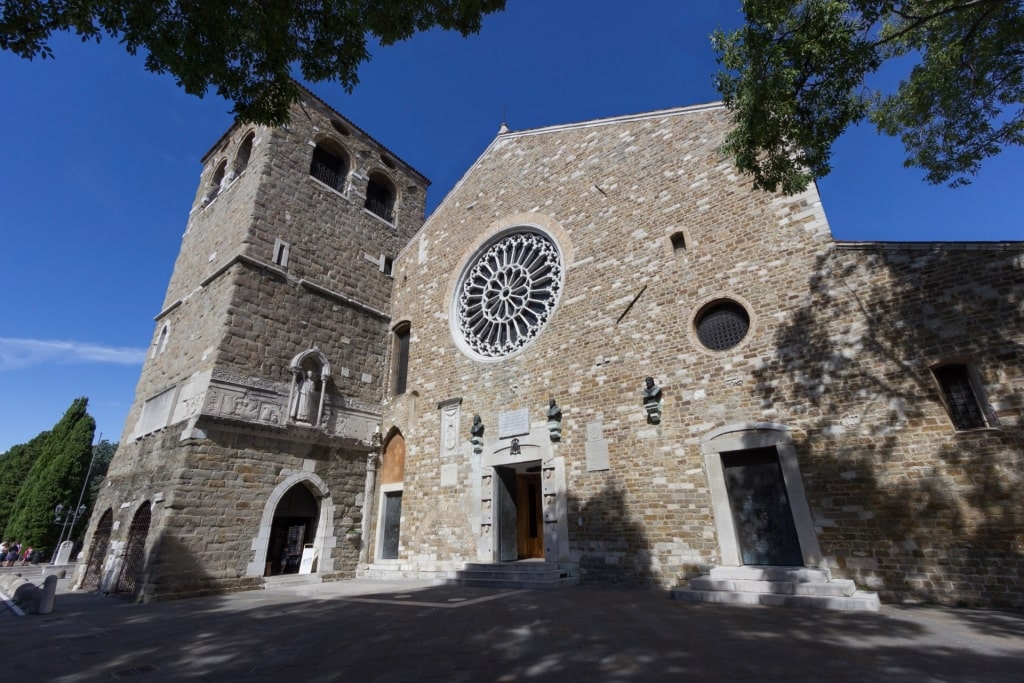
Cattedrale di San Giusto Martire
The Cattedrale di San Giusto Martire, also known as Trieste Cathedral, is the historic heart of Catholicism in the city.
The cathedral’s name derives from Saint Justus, a Catholic saint and former citizen who was drowned in the Gulf of Trieste by the Romans. Perhaps it’s correct that there are wonderful views of the sea from the cathedral’s hillside position.
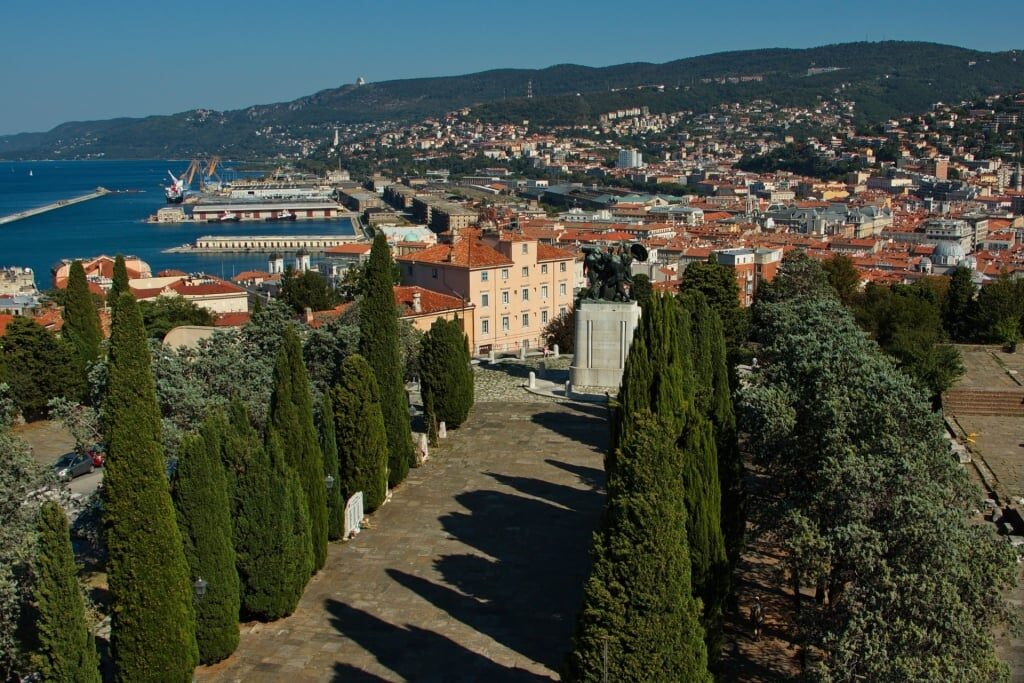
View from the Cattedrale di San Giusto Martire
Adjacent to the Castle of San Giusto, the 14th-century cathedral was built on the remains of a Roman temple. Added to over several centuries, the architectural blend complicates as you step into its cavernous interior, with a synthesis of Romanesque, Gothic, and Baroque elements within.
Its most striking features are its detailed Gothic rose window and the 12th-century mosaics painstakingly created by master Venetian craftsmen. Among these, you’ll find an image of the saintly Justus, risen from the depths, in the company of Christ.
See Art in the Museo Revoltella
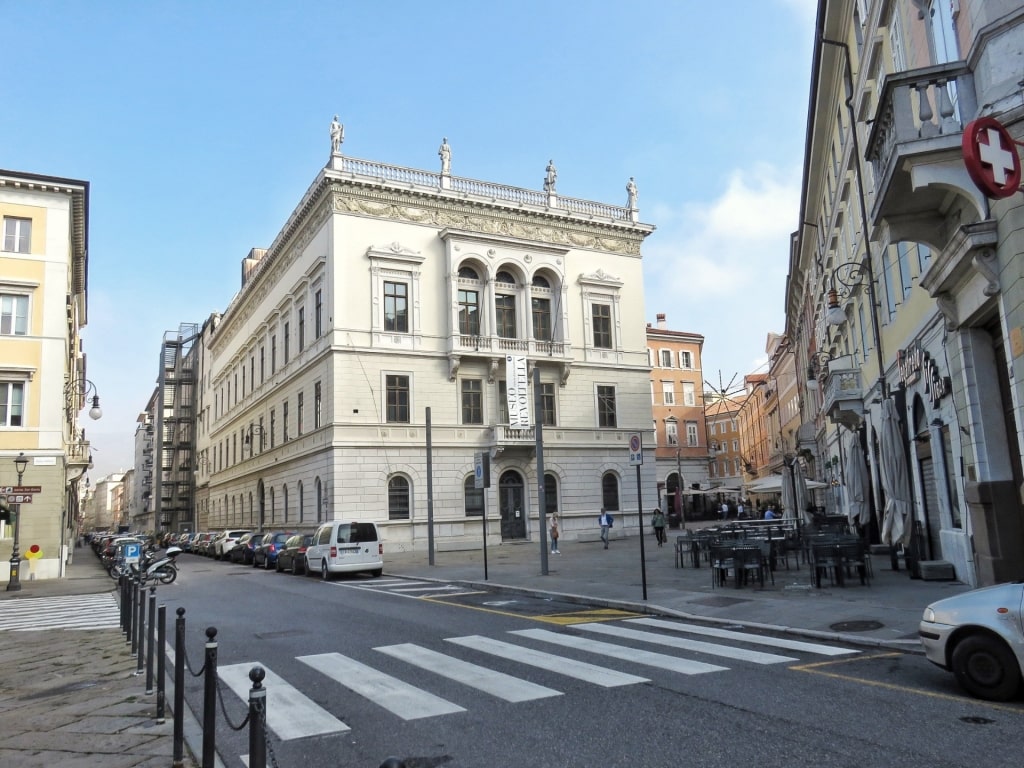
Museo Revoltella Photo by Dage on Flickr, licensed under CC BY 2.0
Located close to the waterfront in central Trieste, Museo Revoltella is one of the city’s cultural highlights.
Its impressive haunt is the former home of Baron Pasquale Revoltella, a wealthy 19th-century timber and grain merchant who acted as a patron to local artists. When he died he bequeathed his mansion, located on high-end Piazza Venezia, to Trieste, along with his impressive collection of contemporary art.
The majority of the collection today, including all of the acquisitions made by the city over the ensuing century, now inhabits the adjacent Palazzo Brunner. In Brunner you’ll find the permanent display, traveling back in time as you ascend through the various floors.
Don’t expect to find a Caravaggio or a Raphael here; the focus is on lesser-known Italian and European talents hailing from close by. Beyond its unique collection, the Museo Revoltella also features cultural events and a panoramic rooftop terrace and café.
Read: Best Art Museums in Italy
Take the Sea Air on Molo Audace
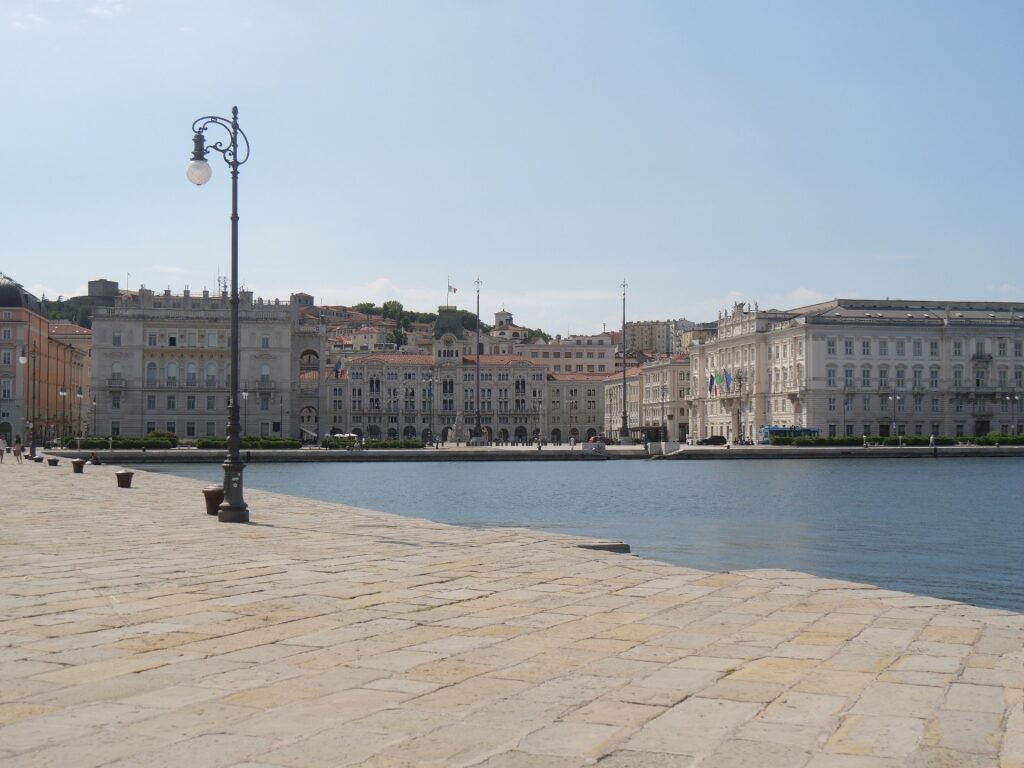
Molo Audace
Strolling out onto the salt-worn flagstones of the Molo Audace, an 18th-century pier, is one of the things to do in Trieste that any local would highly recommend.
Its impressive width gives you the impression of stepping out onto a floating piazza. From its concluding edge, you can turn and take wonderful photographs of the waterfront architecture, especially the Verdi Theater that sits directly behind the pier.
Stone benches spaced out along its length are perfect for moments of contemplation in the salty sea air. The pier is still in use and superyachts and fishing trawlers occasionally glide over to moor up.
Immerse Yourself in Café Culture

Coffee
Vienna is famous for its 19th-century café culture, where intellectuals and artists would meet within elegant halls to sip coffee and share ideas.
This Austro-Hungarian talent for creating atmospheric meeting places carried over to many of the empire’s former territories and neighbors. Trieste is no different.
Of the many intellectuals who held court at Trieste’s marble-topped tables, perhaps the most famous, as denoted by his bow-tied bronze in Borgo Teresiano, is James Joyce. The Irish writer lived in Trieste for many years and spent a good percentage of his time in the grand cafés that still operate today.
These include Caffè degli Specchi in Piazza Unità d’Italia; the frescoed Caffè San Marco; the Art Nouveau Antico Caffè Torinese; and Caffè Stella Polare with its outstanding pastries. Travel back in time with a macchiato at any of these wood-paneled, chandelier-lit haunts, perusing your CliffsNotes study guide of Ulysses for extra credit.
Read: An Insider’s Look at Italian Food Culture
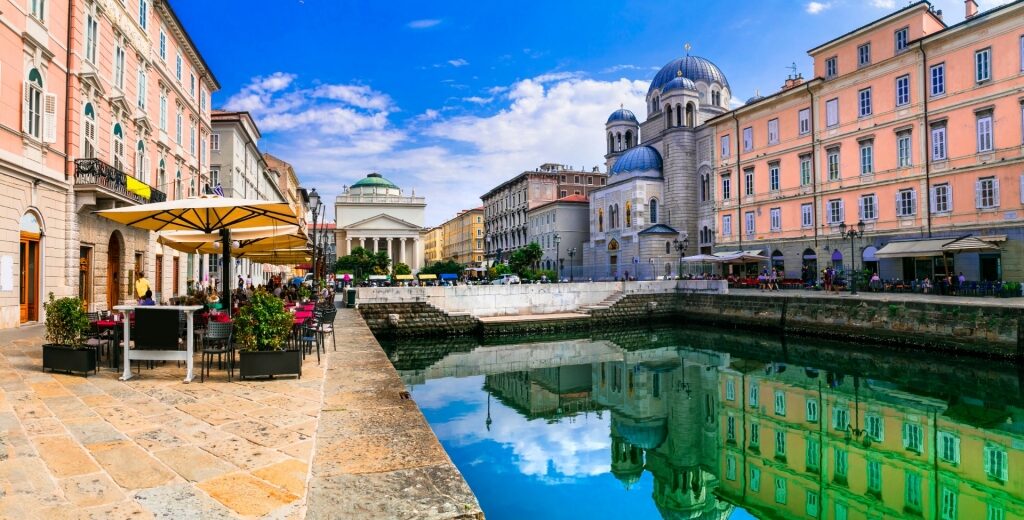
Borgo Teresiano
Explore the many things to do in Trieste on a journey to fabulous Italy. Browse our cruises to Trieste and set off on your next incredible voyage to the Old World.



